Characteristics and Seasonal Variations of Cirrus Clouds from Polarization Lidar Observations at a 30°N Plain Site
Abstract
:1. Introduction
2. Instruments and Methodology
2.1. Instruments
2.1.1. Polarization Lidar
2.1.2. Radiosonde
2.1.3. Cloud Camera
2.2. Methodology
2.2.1. Cloud height
2.2.2. Particle Depolarization Ratio
2.2.3. Lidar Ratio and COD
2.2.4. Multiple Scattering Correction
3. Observational Results
3.1. A Typical Cirrus Cloud Example
3.2. Frequency of Cirrus Occurrence
3.3. Geometrical and Meteorological Properties
3.4. Optical Properties
3.4.1. Optical Depth
3.4.2. Lidar Ratio
3.4.3. Depolarization Ratio
4. Discussion
5. Concluding Remarks
Author Contributions
Funding
Acknowledgments
Conflicts of Interest
References
- Liou, K.-N. Influence of Cirrus Clouds on Weather and Climate Processes: A Global Perspective. Mon. Weather Rev. 1986, 114, 1167. [Google Scholar] [CrossRef]
- Nazaryan, H.; McCormick, M.P.; Menzel, W.P. Global characterization of cirrus clouds using CALIPSO data. J. Geophys. Res. Atmos. 2008, 113. [Google Scholar] [CrossRef]
- Campbell, J.R.; Lolli, S.; Lewis, J.R.; Gu, Y.; Welton, E.J. Daytime Cirrus Cloud Top-of-the-Atmosphere Radiative Forcing Properties at a Midlatitude Site and Their Global Consequences. J. Appl. Meteorol. Climatol. 2016, 55, 1667–1679. [Google Scholar] [CrossRef]
- Solomon, S.; Qin, D.; Manning, M.; Chen, Z.; Marquis, M.; Averyt, K.; Tignor, M.; Miller, H. IPCC, 2007: Climate change 2007: The physical science basis. In Contribution of Working Group I to the Fourth Assessment Report of the Intergovernmental Panel on Climate Change; Cambridge University Press: Cambridge, UK; New York, NY, USA, 2007. [Google Scholar] [CrossRef]
- Fu, Q.; Liou, K.N. Parameterization of the Radiative Properties of Cirrus Clouds. J. Atmos. Sci. 1993, 50, 2008–2025. [Google Scholar] [CrossRef] [Green Version]
- Zerefos, C.S.; Eleftheratos, K.; Balis, D.S.; Zanis, P.; Tselioudis, G.; Meleti, C. Evidence of impact of aviation on cirrus cloud formation. Atmos. Chem. Phys. 2003, 3, 1633–1644. [Google Scholar] [CrossRef] [Green Version]
- Seifert, P.; Ansmann, A.; Müller, D.; Wandinger, U.; Althausen, D.; Heymsfield, A.J.; Massie, S.T.; Schmitt, C. Cirrus optical properties observed with lidar, radiosonde, and satellite over the tropical Indian Ocean during the aerosol-polluted northeast and clean maritime southwest monsoon. J. Geophys. Res. Atmos. 2007, 112. [Google Scholar] [CrossRef]
- Dai, G.; Wu, S.; Song, X.; Liu, L. Optical and Geometrical Properties of Cirrus Clouds over the Tibetan Plateau Measured by LiDAR and Radiosonde Sounding during the Summertime in 2014. Remote Sens. 2019, 11, 302. [Google Scholar] [CrossRef] [Green Version]
- Stocker, T.F.; Qin, D.; Plattner, G.K.; Tignor, M.; Allen, S.K.; Boschung, J.; Nauels, A.; Xia, Y.; Bex, B.; Midgley, B.M. IPCC, 2013: Climate Change 2013: The Physical Science Basis. Contribution of Working Group I to the Fifth Assessment Report of the Intergovernmental Panel on Climate Change; Cambridge University Press: Cambridge, UK; New York, NY, USA, 2013; p. 1535. [Google Scholar]
- Min, M.; Wang, P.; Campbell, J.R.; Zong, X.; Xia, J. Cirrus cloud macrophysical and optical properties over North China from CALIOP measurements. Adv. Atmos. Sci. 2011, 28, 653–664. [Google Scholar] [CrossRef] [Green Version]
- Comstock, J.M.; Ackerman, T.P.; Mace, G.G. Ground-based lidar and radar remote sensing of tropical cirrus clouds at Nauru Island: Cloud statistics and radiative impacts. J. Geophys. Res. Atmos. 2002, 107, AAC 16-11–AAC 16-14. [Google Scholar] [CrossRef]
- Platnick, S.; King, M.D.; Ackerman, S.A.; Menzel, W.P.; Baum, B.A.; Riedi, J.C.; Frey, R.A. The MODIS cloud products: algorithms and examples from Terra. IEEE Trans. Geosci. Remote Sens. 2003, 41, 459–473. [Google Scholar] [CrossRef] [Green Version]
- Gouveia, D.A.; Barja, B.; Barbosa, H.M.J.; Seifert, P.; Baars, H.; Pauliquevis, T.; Artaxo, P. Optical and geometrical properties of cirrus clouds in Amazonia derived from 1 year of ground-based lidar measurements. Atmos. Chem. Phys. 2017, 17, 3619–3636. [Google Scholar] [CrossRef] [Green Version]
- Winker, D.; Pelon, J.; McCormick, M.P. CALIPSO Mission: Spaceborne Lidar for Observation of Aerosols and Clouds; SPIE: Bellingham, WA, USA, 2003; Volume 4893. [Google Scholar]
- Liu, J.; Li, Z.; Zheng, Y.; Cribb, M. Cloud-base distribution and cirrus properties based on micropulse lidar measurements at a site in southeastern China. Adv. Atmos. Sci. 2015, 32, 991–1004. [Google Scholar] [CrossRef] [Green Version]
- Ansmann, A.; Wandinger, U.; Riebesell, M.; Weitkamp, C.; Michaelis, W. Independent measurement of extinction and backscatter profiles in cirrus clouds by using a combined Raman elastic-backscatter lidar. Appl. Opt. 1992, 31, 7113–7131. [Google Scholar] [CrossRef] [PubMed]
- Ansmann, A.; Riebesell, M.; Wandinger, U.; Weitkamp, C.; Voss, E.; Lahmann, W.; Michaelis, W. Combined Raman elastic-backscatter lidar for vertical profiling of moisture, aerosol extinction, backscatter, and lidar ratio. Appl. Phys. B 1992, 55, 18–28. [Google Scholar] [CrossRef]
- Platt, C.; Winker, D.; Vaughan, M.; Miller, S. Backscatter-to-extinction ratios in the top layers of tropical mesoscale convective systems and in isolated cirrus from LITE observations. J. Appl. Meteorol. 1999, 38, 1330–1345. [Google Scholar] [CrossRef]
- Giannakaki, E.; Balis, D.S.; Amiridis, V.; Kazadzis, S. Optical and geometrical characteristics of cirrus clouds over a Southern European lidar station. Atmos. Chem. Phys. 2007, 7, 5519–5530. [Google Scholar] [CrossRef] [Green Version]
- Kong, W.; Yi, F. Convective boundary layer evolution from lidar backscatter and its relationship with surface aerosol concentration at a location of a central China megacity. J. Geophys. Res. Atmos. 2015, 120, 7928–7940. [Google Scholar] [CrossRef]
- He, Y.; Yi, F. Dust Aerosols Detected Using a Ground-Based Polarization Lidar and CALIPSO over Wuhan (30.5° N, 114.4° E), China. Adv. Meteorol. 2015, 2015. [Google Scholar] [CrossRef]
- Wu, C.; Yi, F. Local ice formation via liquid water growth in slowly-ascending humid aerosol/liquid water layers observed with ground-based lidars and radiosondes. J. Geophys. Res. Atmos. 2017, 122, 4479–4493. [Google Scholar] [CrossRef]
- Zhuang, J.; Yi, F. Nabro aerosol evolution observed jointly by lidars at a mid-latitude site and CALIPSO. Atmos. Environ. 2016, 140, 106–116. [Google Scholar] [CrossRef]
- Shao, J.; Yi, F.; Yin, Z. Aerosol layers in the free troposphere and their seasonal variations as observed in Wuhan, China. Atmos. Environ. 2020, 224, 117323. [Google Scholar] [CrossRef]
- Nash, J.; Oakley, T.; Vömel, H.; Li, W. WMO Intercomparison of High Quality Radiosonde Systems; WMO Tech.Doc.WMO/TD-1580; WMO: Geneva, Switzerland, 2011; p. 238. [Google Scholar]
- Zhao, C.; Wang, Y.; Wang, Q.; Li, Z.; Wang, Z.; Liu, D. A new cloud and aerosol layer detection method based on micropulse lidar measurements. J. Geophys. Res. Atmos. 2014, 119, 6788–6802. [Google Scholar] [CrossRef] [Green Version]
- Insperger, T.; Stépán, G. Semi-Discretization for Time-Delay Systems; Springer: New York, NY, USA, 2011. [Google Scholar]
- Lakkis, S.G.; Lavorato, M.; Canziani, P.; Lacomi, H. Lidar observations of cirrus clouds in Buenos Aires. J. Atmos. Sol. Terr. Phys. 2015, 130–131, 89–95. [Google Scholar] [CrossRef]
- Wang, Z.; Chi, R.; Liu, B.; Zhou, J. Depolarization properties of cirrus clouds from polarization lidar measurements over Hefei in spring. Chin. Opt. Lett. 2008, 6, 235–237. [Google Scholar] [CrossRef]
- Campbell, J.R.; Vaughan, M.A.; Oo, M.; Holz, R.E.; Lewis, J.R.; Welton, E.J. Distinguishing cirrus cloud presence in autonomous lidar measurements. Atmos. Meas. Tech. 2015, 8, 435–449. [Google Scholar] [CrossRef] [Green Version]
- Sassen, K.; Campbell, J.R. A midlatitude cirrus cloud climatology from the Facility for Atmospheric Remote Sensing. Part I: Macrophysical and synoptic properties. J. Atmos. Sci. 2001, 58, 481–496. [Google Scholar] [CrossRef]
- Freudenthaler, V. About the effects of polarising optics on lidar signals and the Δ90 calibration. Atmos. Meas. Tech. 2016, 9, 4181–4255. [Google Scholar] [CrossRef] [Green Version]
- Freudenthaler, V.; Esselborn, M.; Wiegner, M.; Heese, B.; Tesche, M.; Ansmann, A.; Müller, D.; Althausen, D.; Wirth, M.; Fix, A. Depolarization ratio profiling at several wavelengths in pure Saharan dust during SAMUM 2006. Tellus B 2009, 61, 165–179. [Google Scholar] [CrossRef] [Green Version]
- Behrendt, A.; Nakamura, T. Calculation of the calibration constant of polarization lidar and its dependency on atmospheric temperature. Opt. Express 2002, 10, 805–817. [Google Scholar] [CrossRef]
- Klett, J.D. Stable analytical inversion solution for processing lidar returns. Appl. Opt. 1981, 20, 211–220. [Google Scholar] [CrossRef] [Green Version]
- Fernald, F.G. Analysis of atmospheric lidar observations- Some comments. Appl. Opt. 1984, 23, 652–653. [Google Scholar] [CrossRef] [PubMed]
- Cadet, B.; Giraud, V.; Haeffelin, M.; Keckhut, P.; Rechou, A.; Baldy, S. Improved retrievals of the optical properties of cirrus clouds by a combination of lidar methods. Appl. Opt. 2005, 44, 1726–1734. [Google Scholar] [CrossRef] [PubMed]
- Bissonnette, L.R.; Bruscaglioni, P.; Ismaelli, A.; Zaccanti, G.; Cohen, A.; Benayahu, Y.; Kleiman, M.; Egert, S.; Flesia, C.; Schwendimann, P.; et al. LIDAR multiple scattering from clouds. Appl. Phys. B 1995, 60, 355–362. [Google Scholar] [CrossRef]
- Wang, X.; Boselli, A.; D’Avino, L.; Velotta, R.; Spinelli, N.; Bruscaglioni, P.; Ismaelli, A.; Zaccanti, G. An algorithm to determine cirrus properties from analysis of multiple-scattering influence on lidar signals. Appl. Phys. B 2005, 80, 609–615. [Google Scholar] [CrossRef]
- Wandinger, U. Multiple-scattering influence on extinction- and backscatter-coefficient measurements with Raman and high-spectral-resolution lidars. Appl. Opt. 1998, 37, 417–427. [Google Scholar] [CrossRef]
- Platt, C.M.R. Remote Sounding of High Clouds. III: Monte Carlo Calculations of Multiple-Scattered Lidar Returns. J. Atmos. Sci. 1981, 38, 156–167. [Google Scholar] [CrossRef] [Green Version]
- Comstock, J.M.; Sassen, K. Retrieval of Cirrus Cloud Radiative and Backscattering Properties Using Combined Lidar and Infrared Radiometer (LIRAD) Measurements. J. Atmos. Ocean. Technol. 2001, 18, 1658–1673. [Google Scholar] [CrossRef]
- Hogan, R.J. Fast approximate calculation of multiply scattered lidar returns. Appl. Opt. 2006, 45, 5984–5992. [Google Scholar] [CrossRef]
- Wang, Z.; Sassen, K. Cirrus Cloud Microphysical Property Retrieval Using Lidar and Radar Measurements. Part II: Midlatitude Cirrus Microphysical and Radiative Properties. J. Atmos. Sci. 2002, 59, 2291–2302. [Google Scholar] [CrossRef]
- Gelaro, R.; McCarty, W.; Suárez, M.J.; Todling, R.; Molod, A.; Takacs, L.; Randles, C.A.; Darmenov, A.; Bosilovich, M.G.; Reichle, R.; et al. The Modern-Era Retrospective Analysis for Research and Applications, Version 2 (MERRA-2). J. Clim. 2017, 30, 5419–5454. [Google Scholar] [CrossRef]
- Liu, D.; Wang, Z.; Liu, Z.; Winker, D.; Trepte, C. A height resolved global view of dust aerosols from the first year CALIPSO lidar measurements. J. Geophys. Res. Atmos. 2008, 113. [Google Scholar] [CrossRef]
- Liu, D.; Zhao, T.; Boiyo, R.; Chen, S.; Lu, Z.; Wu, Y.; Zhao, Y. Vertical Structures of Dust Aerosols over East Asia Based on CALIPSO Retrievals. Remote Sens. 2019, 11, 701. [Google Scholar] [CrossRef] [Green Version]
- Chiang, J.C.H.; Swenson, L.M.; Kong, W. Role of seasonal transitions and the westerlies in the interannual variability of the East Asian summer monsoon precipitation. Geophys. Res. Lett. 2017, 44, 3788–3795. [Google Scholar] [CrossRef]
- DeMott, P.J.; Cziczo, D.J.; Prenni, A.J.; Murphy, D.M.; Kreidenweis, S.M.; Thomson, D.S.; Borys, R.; Rogers, D.C. Measurements of the concentration and composition of nuclei for cirrus formation. Proc. Natl. Acad. Sci. USA 2003, 100, 14655–14660. [Google Scholar] [CrossRef] [PubMed] [Green Version]
- Sassen, K.; Wang, Z.; Liu, D. Global distribution of cirrus clouds from CloudSat/Cloud-Aerosol Lidar and Infrared Pathfinder Satellite Observations (CALIPSO) measurements. J. Geophys. Res. Atmos. 2008, 113. [Google Scholar] [CrossRef]
- Huang, R.; Sun, F. Impacts of the tropical western Pacific on the East Asian summer monsoon. J. Meteorol. Soc. Jpn. Ser. Ii 1992, 70, 243–256. [Google Scholar] [CrossRef] [Green Version]
- Yihui, D.; Chan, J.C.L. The East Asian summer monsoon: an overview. Meteorol. Atmos. Phys. 2005, 89, 117–142. [Google Scholar] [CrossRef]
- Cziczo, D.J.; Froyd, K.D.; Hoose, C.; Jensen, E.J.; Diao, M.; Zondlo, M.A.; Smith, J.B.; Twohy, C.H.; Murphy, D.M. Clarifying the Dominant Sources and Mechanisms of Cirrus Cloud Formation. Science 2013, 340, 1320–1324. [Google Scholar] [CrossRef] [Green Version]
- Platt, C.M.R.; Scott, S.C.; Dilley, A.C. Remote Sounding of High Clouds. Part VI: Optical Properties of Midlatitude and Tropical Cirrus. J. Atmos. Sci. 1987, 44, 729–747. [Google Scholar] [CrossRef] [Green Version]
- Sunilkumar, S.V.; Parameswaran, K. Temperature dependence of tropical cirrus properties and radiative effects. J. Geophys. Res. Atmos. 2005, 110. [Google Scholar] [CrossRef]
- Sassen, K.; Cho, B.S. Subvisual-Thin Cirrus Lidar Dataset for Satellite Verification and Climatological Research. J. App. Meteo. 1992, 31, 1275–1285. [Google Scholar] [CrossRef] [Green Version]
- Wang, J.; Zhang, L.; Huang, J.; Cao, X.; Liu, R.; Zhou, B.; Wang, H.; Huang, Z.; Bi, J.; Zhou, T.; et al. Macrophysical and optical properties of mid-latitude cirrus clouds over a semi-arid area observed by micro-pulse lidar. J. Quant. Spectrosc. Radiat. Transf. 2013, 122, 3–12. [Google Scholar] [CrossRef]
- Das, S.K.; Chiang, C.-W.; Nee, J.-B. Characteristics of cirrus clouds and its radiative properties based on lidar observation over Chung-Li, Taiwan. Atmos. Res. 2009, 93, 723–735. [Google Scholar] [CrossRef]
- Sassen, K.; Comstock, J.M. A Midlatitude Cirrus Cloud Climatology from the Facility for Atmospheric Remote Sensing. Part III: Radiative Properties. J. Atmos. Sci. 2001, 58, 2113–2127. [Google Scholar] [CrossRef]
- Sassen, K.; Wang, Z.; Platt, C.M.R.; Comstock, J.M. Parameterization of Infrared Absorption in Midlatitude Cirrus Clouds. J. Atmos. Sci. 2003, 60, 428–433. [Google Scholar] [CrossRef]
- Heymsfield, A.J.; Platt, C. A parameterization of the particle size spectrum of ice clouds in terms of the ambient temperature and the ice water content. J. Atmos. Sci. 1984, 41, 846–855. [Google Scholar] [CrossRef] [Green Version]
- Sassen, K.; Griffin, M.K.; Dodd, G.C. Optical Scattering and Microphysical Properties of Subvisual Cirrus Clouds, and Climatic Implications. J. Appl. Meteorol. 1989, 28, 91–98. [Google Scholar] [CrossRef] [Green Version]
- Reichardt, J.; Reichardt, S.; Hess, M.; McGee, T.J. Correlations among the optical properties of cirrus-cloud particles: Microphysical interpretation. J. Geophys. Res. Atmos. 2002, 107, AAC 8-1–AAC 8-12. [Google Scholar] [CrossRef]
- Gonda, T.; Yamazaki, T. Morphology of ice droxtals grown from supercooled water droplets. J. Cryst. Growth 1978, 45, 66–69. [Google Scholar] [CrossRef]
- Heymsfield, A.J. Laboratory and Field Observations of the Growth of Columnar and Plate Crystals from Frozen Droplets. J. Atmos. Sci. 1973, 30, 1650–1656. [Google Scholar] [CrossRef] [Green Version]
- Chylek, P.; Dubey, M.K.; Lohmann, U.; Ramanathan, V.; Kaufman, Y.J.; Lesins, G.; Hudson, J.; Altmann, G.; Olsen, S. Aerosol indirect effect over the Indian Ocean. Geophys. Res. Lett. 2006, 33. [Google Scholar] [CrossRef] [Green Version]
- Noel, V.; Chepfer, H.; Ledanois, G.; Delaval, A.; Flamant, P.H. Classification of particle effective shape ratios in cirrus clouds based on the lidar depolarization ratio. Applied Optics 2002, 41, 4245–4257. [Google Scholar] [CrossRef] [PubMed]
- Noel, V.; Chepfer, H.; Haeffelin, M.; Morille, Y. Classification of Ice Crystal Shapes in Midlatitude Ice Clouds from Three Years of Lidar Observations over the SIRTA Observatory. J. Atmos. Sci. 2006, 63, 2978–2991. [Google Scholar] [CrossRef] [Green Version]
- Sassen, K.; Benson, S. A midlatitude cirrus cloud climatology from the Facility for Atmospheric Remote Sensing. Part II: Microphysical properties derived from lidar depolarization. J. Atmos. Sci. 2001, 58, 2103–2112. [Google Scholar] [CrossRef]
- Wandinger, U.; Ansmann, A.; Weitkamp, C. Atmospheric Raman depolarization-ratio measurements. Appl. Opt. 1994, 33, 5671–5673. [Google Scholar] [CrossRef]
- Sassen, K.; Takano, Y. Parry arc: a polarization lidar, ray-tracing, and aircraft case study. Appl. Opt. 2000, 39, 6738–6745. [Google Scholar] [CrossRef]
- Sassen, K. Remote Sensing of Planar Ice Crystal Fall Attitudes. J. Meteorol. Soc. Jpn. 1980, 58, 422–429. [Google Scholar] [CrossRef] [Green Version]
- Noel, V.; Winker, D.M.; Garrett, T.J.; Mcgill, M. Extinction coefficients retrieved in deep tropical ice clouds from lidar observations using a CALIPSO-like algorithm compared to in-situ measurements from the Cloud Integrated Nephelometer during CRYSTAL-FACE. Atmos. Chem. Phys. Discuss. 2006, 6, 10649–10672. [Google Scholar] [CrossRef] [Green Version]
- Chen, B.; Liu, X. Seasonal migration of cirrus clouds over the Asian Monsoon regions and the Tibetan Plateau measured from MODIS/Terra. Geophys. Res. Lett. 2005, 32. [Google Scholar] [CrossRef] [Green Version]
- Jensen, E.J.; Toon, O.B.; Selkirk, H.B.; Spinhirne, J.D.; Schoeberl, M.R. On the formation and persistence of subvisible cirrus clouds near the tropical tropopause. J. Geophys. Res. Atmos. 1996, 101, 21361–21375. [Google Scholar] [CrossRef]
- Immler, F.; Schrems, O. LIDAR measurements of cirrus clouds in the northern and southern midlatitudes during INCA (55° N, 53° S): A comparative study. Geophys. Res. Lett. 2002, 29, 56-1–56-4. [Google Scholar] [CrossRef] [Green Version]
- Keckhut, P.; Hauchecorne, A.; Bekki, S.; Colette, A.; David, C.; Jumelet, J. Indications of thin cirrus clouds in the stratosphere at mid-latitudes. Atmos. Chem. Phys. 2005, 5, 3407–3414. [Google Scholar] [CrossRef] [Green Version]
- Tao, S.Y.; Chen, L.X. A review of recent research on the East Asian summer monsoon in China. In Monsoon Meteorology; Chang, C.P., Krishnamurti, T.N., Eds.; Oxford University Press: Oxford, UK, 1987; pp. 60–92. [Google Scholar]
- Liu, C.; Zipser, E.J. Global distribution of convection penetrating the tropical tropopause. J. Geophys. Res. Atmos. 2005, 110. [Google Scholar] [CrossRef] [Green Version]
- Lakkis, S.G.; Lavorato, M.; Canziani, P.O. Monitoring cirrus clouds with lidar in the Southern Hemisphere: A local study over Buenos Aires. 1. Tropopause heights. Atmos. Res. 2009, 92, 18–26. [Google Scholar] [CrossRef] [Green Version]
- Voudouri, K.A.; Giannakaki, E.; Komppula, M.; Balis, D. Variability in cirrus cloud properties using a PollyXT Raman lidar over high and tropical latitudes. Atmos. Chem. Phys. 2020, 20, 4427–4444. [Google Scholar] [CrossRef] [Green Version]
- Kim, Y.; Kim, S.-W.; Kim, M.-H.; Yoon, S.-C. Geometric and optical properties of cirrus clouds inferred from three-year ground-based lidar and CALIOP measurements over Seoul, Korea. Atmos. Res. 2014, 139, 27–35. [Google Scholar] [CrossRef]
- Dupont, J.-C.; Haeffelin, M.; Morille, Y.; Noël, V.; Keckhut, P.; Winker, D.; Comstock, J.; Chervet, P.; Roblin, A. Macrophysical and optical properties of midlatitude cirrus clouds from four ground-based lidars and collocated CALIOP observations. J. Geophys. Res. Atmos. 2010, 115. [Google Scholar] [CrossRef] [Green Version]
- Sicard, M.; Pérez, C.; Rocadenbosch, F.; Baldasano, J.; García-Vizcaino, D. Mixed-layer depth determination in the Barcelona coastal area from regular lidar measurements: methods, results and limitations. Boundary Layer Meteorol. 2006, 119, 135–157. [Google Scholar] [CrossRef] [Green Version]
- Pandit, A.K.; Gadhavi, H.; Ratnam, M.V.; Raghunath, K.; Rao, S.V.B.; Jayaraman, A. Long-term trend analysis and climatology of tropical cirrus clouds using 16 years of lidar data set over Southern India. Atmos. Chem. Phys. 2015, 15, 13833–13848. [Google Scholar] [CrossRef] [Green Version]
- Pace, G.; Cacciani, M.; di Sarra, A.; Fiocco, G.; Fuà, D. Lidar observations of equatorial cirrus clouds at Mahé Seychelles. J. Geophys. Res. Atmos. 2003, 108. [Google Scholar] [CrossRef] [Green Version]
- Dionisi, D.; Keckhut, P.; Liberti, G.L.; Cardillo, F.; Congeduti, F. Midlatitude cirrus classification at Rome Tor Vergata through a multichannel Raman-Mie-Rayleigh lidar. Atmos. Chem. Phys. 2013, 13, 11853–11868. [Google Scholar] [CrossRef] [Green Version]
- Mace, G.G.; Deng, M.; Soden, B.; Zipser, E. Association of Tropical Cirrus in the 10–15-km Layer with Deep Convective Sources: An Observational Study Combining Millimeter Radar Data and Satellite-Derived Trajectories. J. Atmos. Sci. 2004, 63, 480–503. [Google Scholar] [CrossRef]
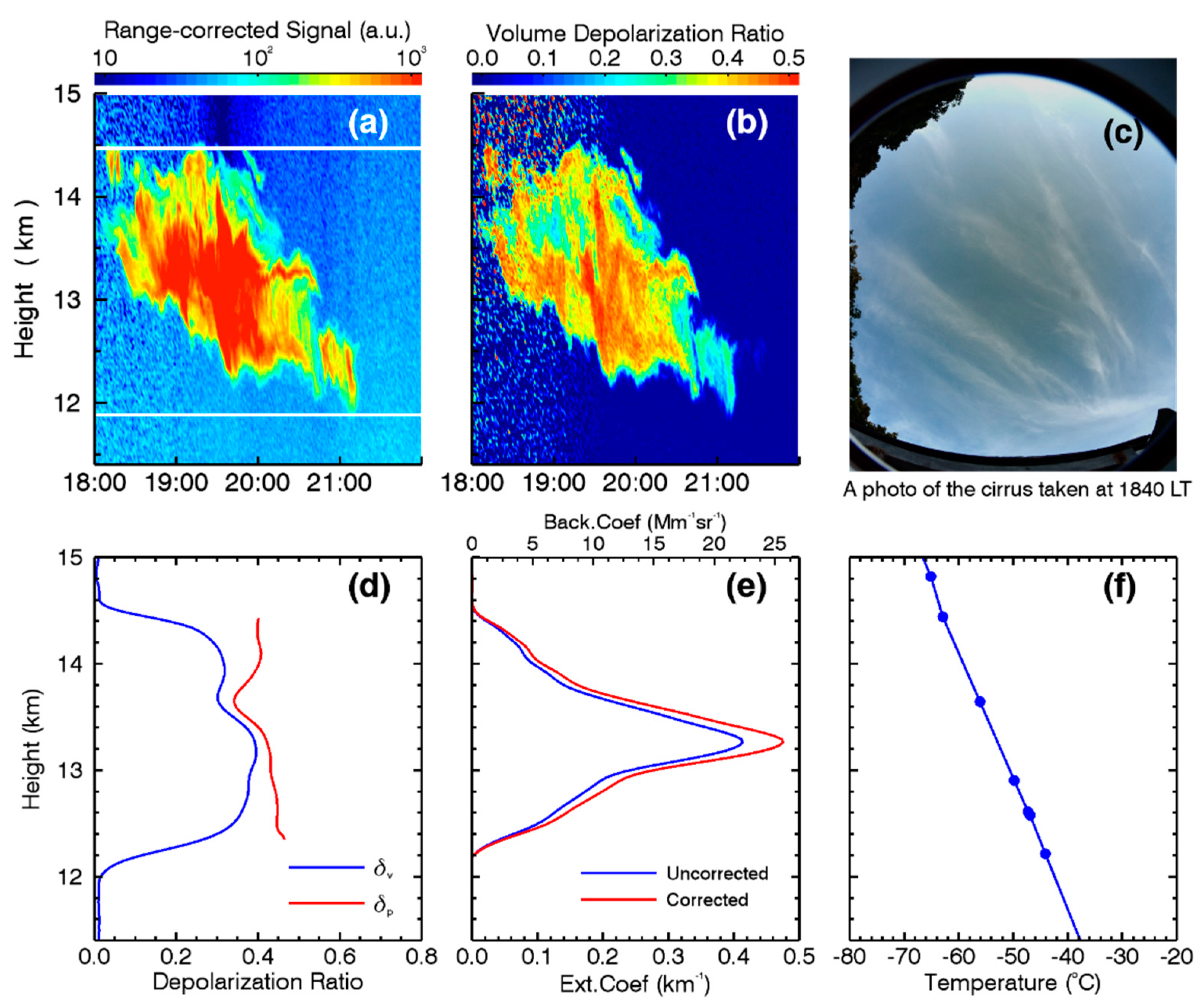
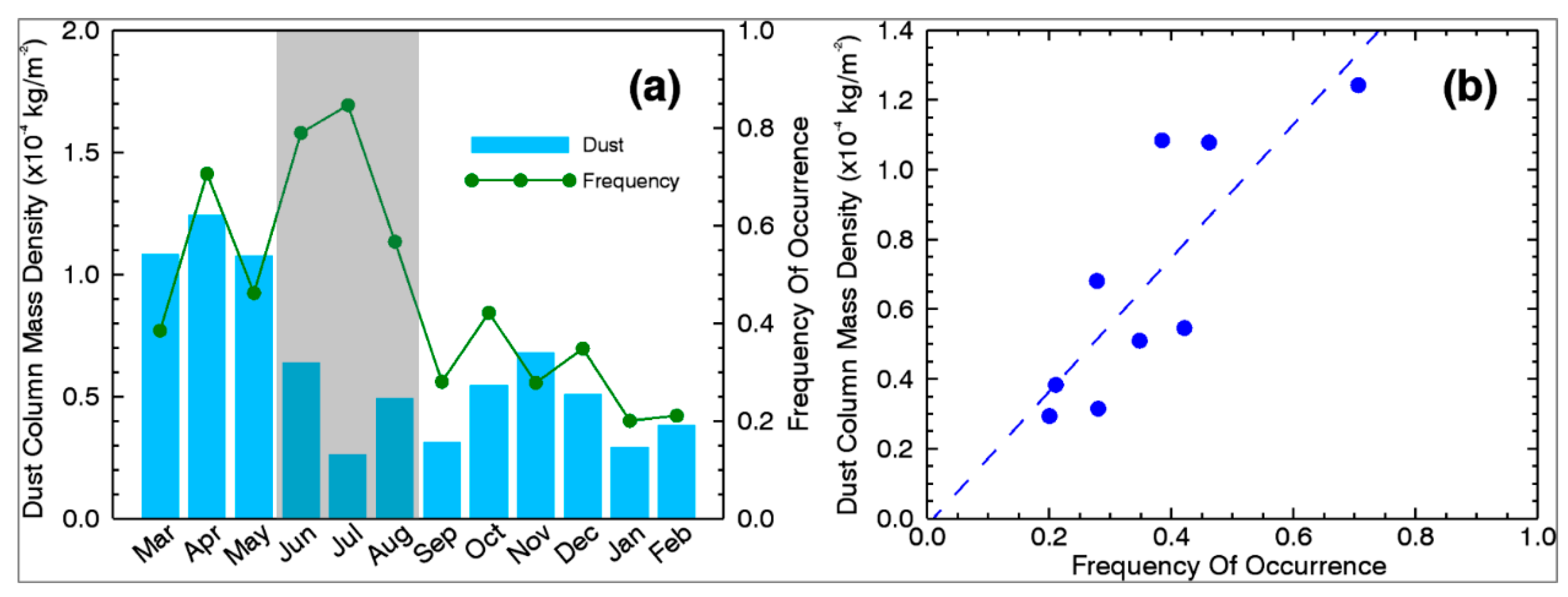
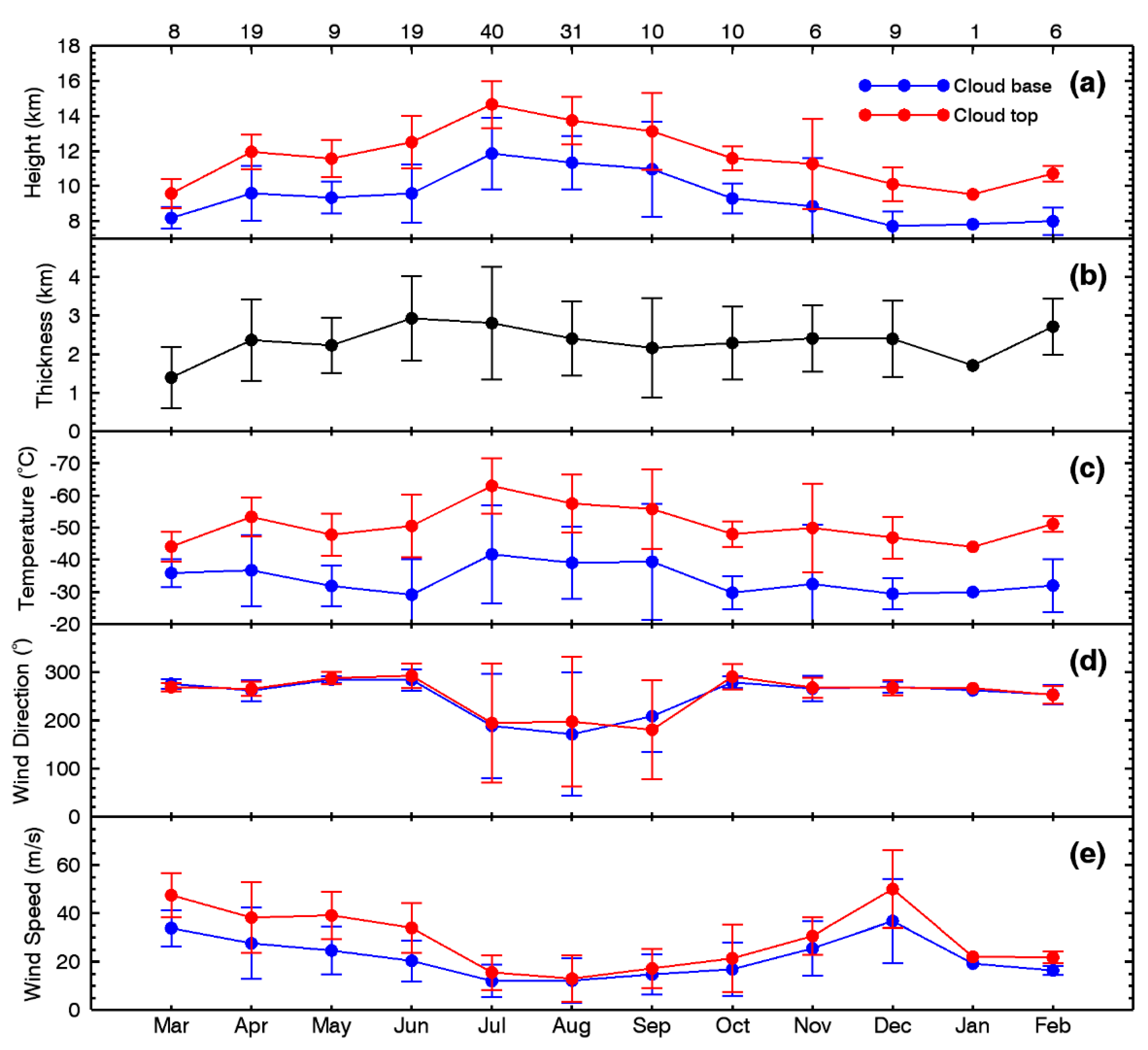
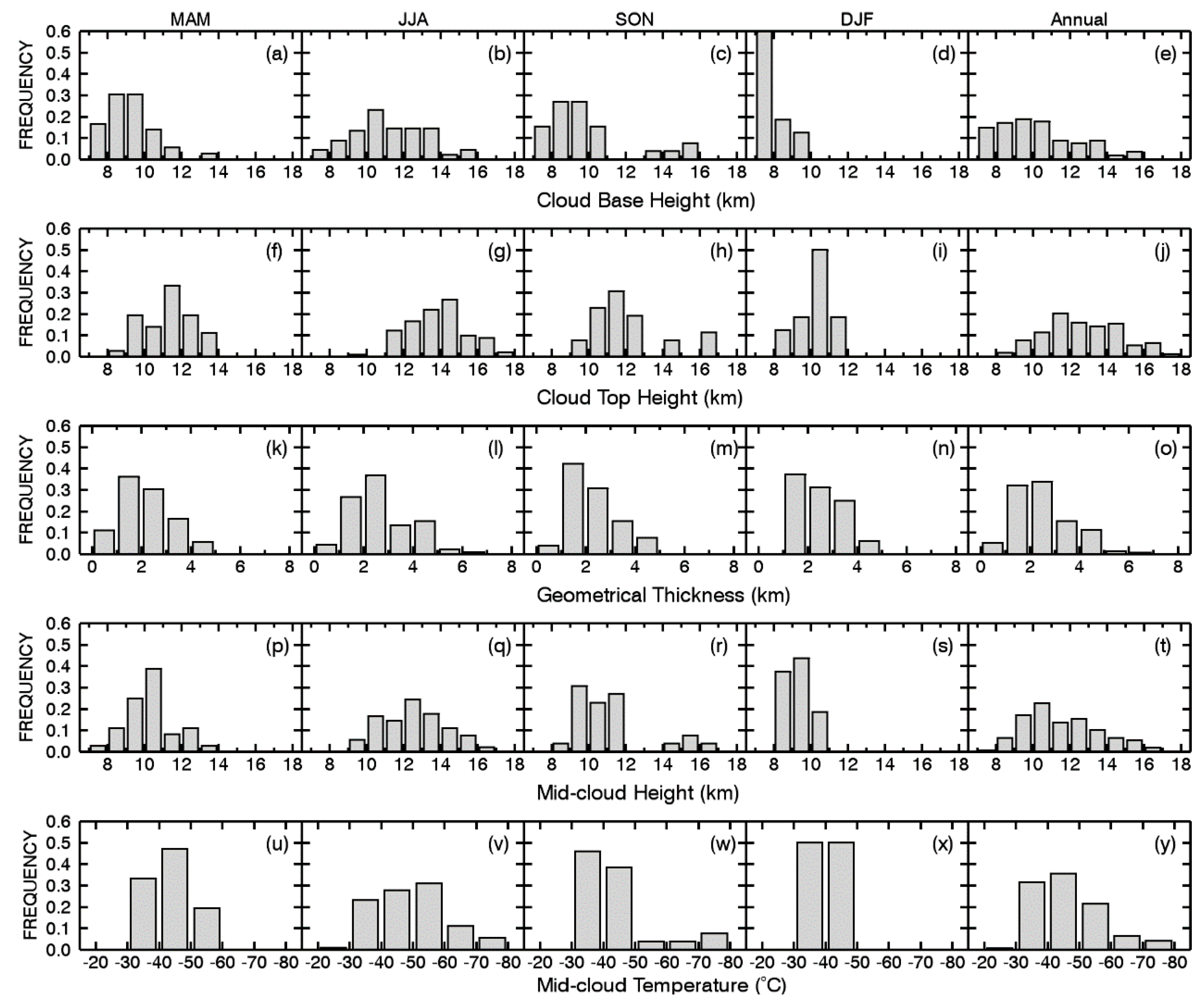

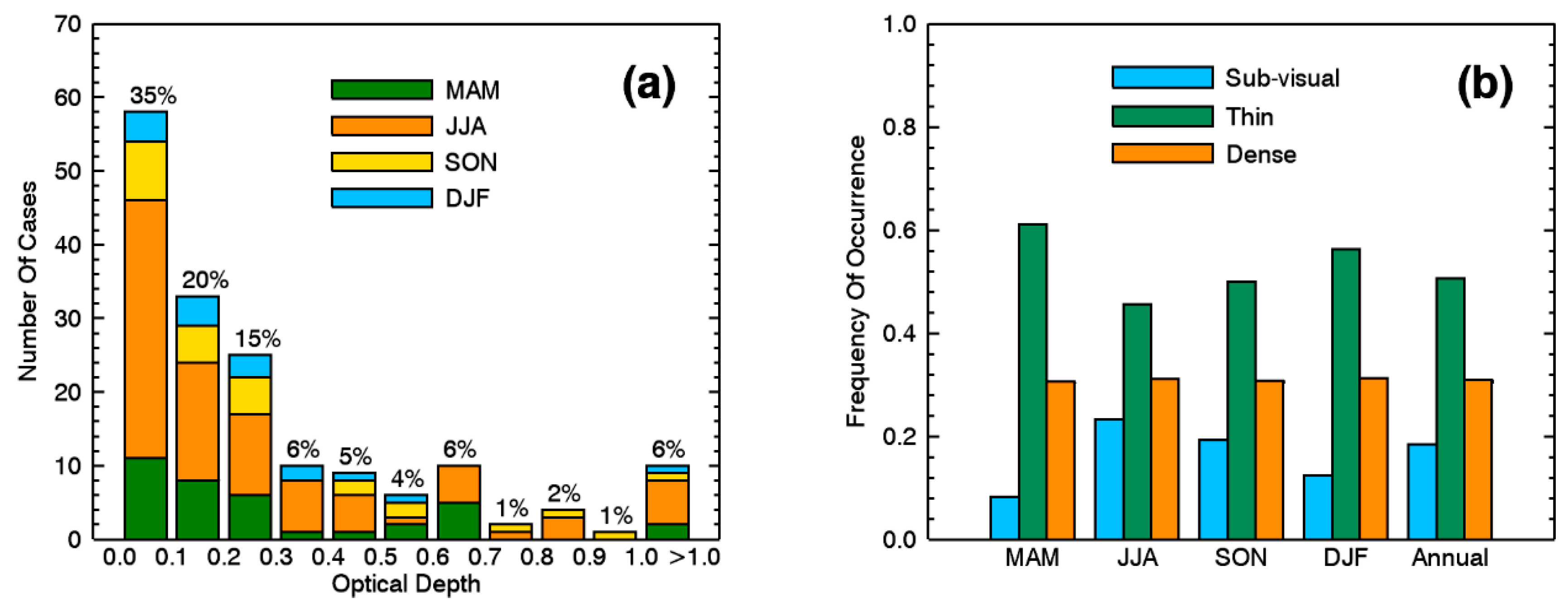

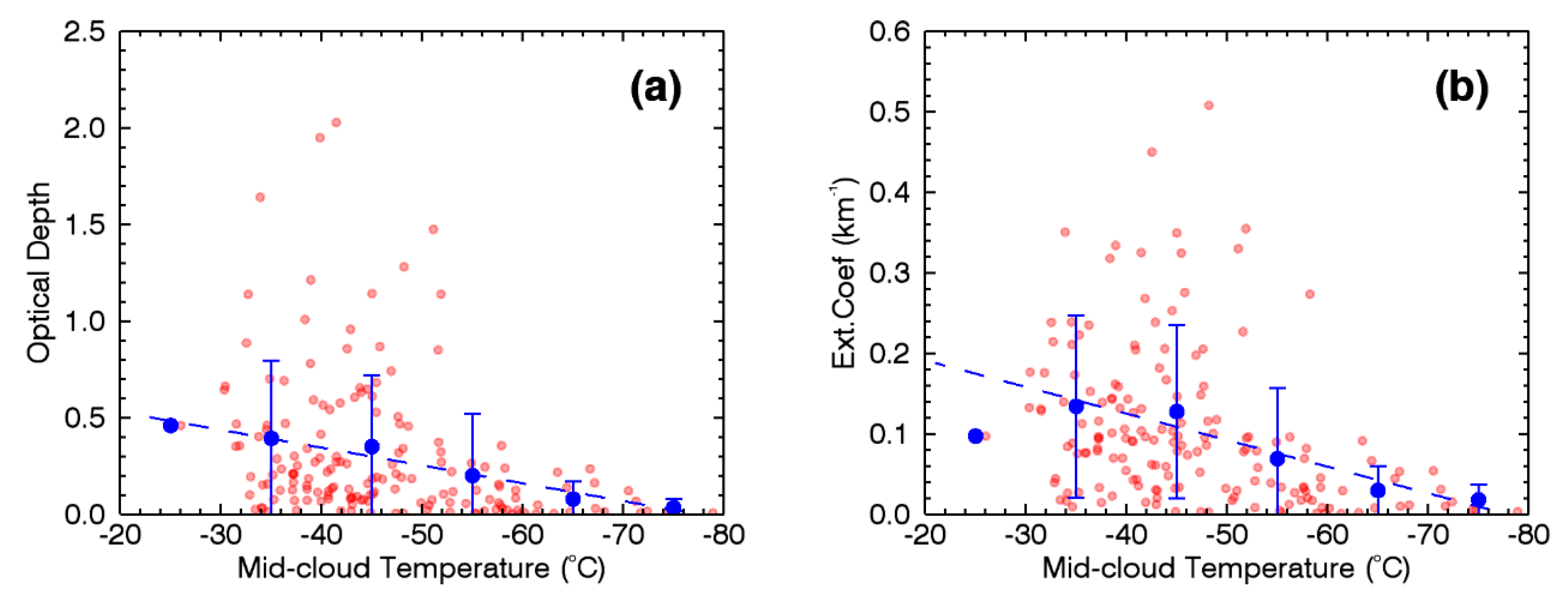





| Cloud Base Height, km | Cloud Top Height, km | Geometrical Thickness, km | Mid-Cloud Height, km | Mid-Cloud Temperature, °C | |
|---|---|---|---|---|---|
| MAM | 9.2 (1.3) | 11.3 (1.4) | 2.1 (1.0) | 10.4 (1.2) | −43.8 (6.4) |
| JJA | 11.2 (2.0) | 13.9 (1.6) | 2.7 (1.2) | 12.6 (1.7) | −49.0 (11.7) |
| SON | 9.8 (2.3) | 12.1 (2.0) | 2.3 (1.0) | 11.1 (2.0) | −44.5 (12.1) |
| DJF | 7.8 (0.8) | 10.3 (0.8) | 2.5 (0.9) | 9.2 (0.7) | −41.2 (5.4) |
| Annual | 10.2 (2.2) | 12.7 (2.0) | 2.5 (1.1) | 11.6 (2.0) | −46.4 (10.7) |
| Optical Depth | SBV/Thin/Dense (%) | Extinction Coefficient, km−1 | Lidar Ratio, sr | Depolarization Ratio | |
|---|---|---|---|---|---|
| MAM | 0.30 (0.31) | 8/61/31 | 0.13 (0.10) | 25.4 (9.6) | 0.29 (0.10) |
| JJA | 0.29 (0.39) | 23/46/31 | 0.09 (0.09) | 21.2 (6.4) | 0.33 (0.08) |
| SON | 0.30 (0.31) | 19/50/31 | 0.12 (0.11) | 18.9 (7.0) | 0.26 (0.10) |
| DJF | 0.33 (0.46) | 13/56/31 | 0.13 (0.16) | 20.4 (6.0) | 0.26 (0.05) |
| Annual | 0.30 (0.36) | 18/51/31 | 0.11 (0.11) | 21.6 (7.5) | 0.30 (0.09) |
| Location | Measurement Period | Wave-Length (nm) | CBH 1 (km) | CTH 2 (km) | GT 3 (km) | Temperature (℃) | COD | SBV/Thin/Dense 4 (%) | Lidar Ratio (sr) | Depolarization Ratio |
|---|---|---|---|---|---|---|---|---|---|---|
| Kuopio [81] 62.74°N, 27.54°E | Nov. 2012–2019 | 355/532/1064 | 8.6 ± 1.1 | 9.8 ± 1.1 | 1.2 ± 0.7 | −43 ± 10 (base) −57 ± 9 (top) 5 | 0.24 ± 0.20 | 3/71/26 | 31 ± 7 | 0.38 ± 0.07 |
| Thessaloniki [19] 40.6°N, 22.9°E | 2000–2006 | 355/532 | 9.0 ±1.1 | 11.7 ± 0.9 | 2.7 ± 0.9 | −52 (mid) 6 | 0.31 ± 0.24 | 3/57/40 | 30 ± 17 | |
| Salt Lake City [31,69] 40.8°N, 111.8°W | 1986-1996 | 694 | 8.8 | 11.2 | 1.81 | −34 (base) −54 (top) | - | 16/35/48 | 24 ± 38 | 0.33 ± 0.11 |
| Seoul [82] 37.5°N, 127. 0°E | Jul. 2006–Jun. 2009 | 532/1064 | 8.8 ± 1.4 | 10.6 ± 1.2 | - | - | 0.42 ± 0.40 | 50 (<0.3) | 25 (assumption) | 0.30 ± 0.06 |
| COVE [83] 37°N, 76°W | 2006–2008 | 532/1064 | 9.8 ± 1.8 | 11.6 ± 1.6 | 1.85 ± 0.97 | - | - | 10/50/40 | - | - |
| Wuhan (this study) 30.5°N, 114.4°E | Mar.2019– Feb.2020 | 532 | 10.2 ± 2.2 | 12.7 ± 2.0 | 2.5 ± 1.1 | −46 ± 11 (mid) | 0.30 ± 0.36 | 18/51/31 | 21.6 ± 7.5 | 0.30 ± 0.09 |
| Gwal Pahari [81] 28.43°N, 77.15°E | Mar. 2008–Mar. 2009 | 355/532/1064 | 9.0 ± 1.6 | 10.6 ± 1.8 | 1.5 ± 0.7 | −33 ± 6 (base) −45 ± 4 (top) | 0.45 ± 0.30 | 0/20/80 | 28 ± 22 | - |
| Chung-Li [84] 24.58°N,121.10°E | 1999–2006 | 532 | 12.3 ± 2.2 | 14.4 ± 1.9 | 2.08 ± 1.2 | - | 0.16 ± 0.27 | 38/47/15 | 23 ± 16 | 0.2 (peak occurrence) |
| Gadanki [85] 13.5°N, 79.2°E | 1998–2013 | 532 | 13.0 ± 2.2 | 15.3 ± 2.0 | 2.3 ± 1.3 | −65 ± 12 (mid) | - | 52/36/11 | 25 (assumption) | - |
| Hulule [7] 4.1°N, 73.3°E, | 1999, 2000 | 532 | 11.9 ±1.6 | 11.9 ± 1.6 | 1.8 ± 1.0 | −58 ± 11 (mid) | 0.28 ± 0.29 | 15/49/36 | 32 ± 10 | - |
| Amazonia [13] 2.89°S, 59.97°W | Jul. 2011–Jun. 2012 | 355 | 12.9 ± 2.2 | 14.3 ± 1.9 | 1.4 ± 1.1 | −60 ± 15 (max. back) 7 | 0.25 ± 0.46 | 41.6/37.8/20.5 | 23.3 ± 8.0 | - |
Publisher’s Note: MDPI stays neutral with regard to jurisdictional claims in published maps and institutional affiliations. |
© 2020 by the authors. Licensee MDPI, Basel, Switzerland. This article is an open access article distributed under the terms and conditions of the Creative Commons Attribution (CC BY) license (http://creativecommons.org/licenses/by/4.0/).
Share and Cite
Wang, W.; Yi, F.; Liu, F.; Zhang, Y.; Yu, C.; Yin, Z. Characteristics and Seasonal Variations of Cirrus Clouds from Polarization Lidar Observations at a 30°N Plain Site. Remote Sens. 2020, 12, 3998. https://doi.org/10.3390/rs12233998
Wang W, Yi F, Liu F, Zhang Y, Yu C, Yin Z. Characteristics and Seasonal Variations of Cirrus Clouds from Polarization Lidar Observations at a 30°N Plain Site. Remote Sensing. 2020; 12(23):3998. https://doi.org/10.3390/rs12233998
Chicago/Turabian StyleWang, Wei, Fan Yi, Fuchao Liu, Yunpeng Zhang, Changming Yu, and Zhenping Yin. 2020. "Characteristics and Seasonal Variations of Cirrus Clouds from Polarization Lidar Observations at a 30°N Plain Site" Remote Sensing 12, no. 23: 3998. https://doi.org/10.3390/rs12233998
APA StyleWang, W., Yi, F., Liu, F., Zhang, Y., Yu, C., & Yin, Z. (2020). Characteristics and Seasonal Variations of Cirrus Clouds from Polarization Lidar Observations at a 30°N Plain Site. Remote Sensing, 12(23), 3998. https://doi.org/10.3390/rs12233998






